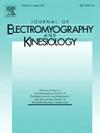An objective method to quantify elbow flexor spasticity using surface EMG and 3D motion analysis
IF 2.3
4区 医学
Q3 NEUROSCIENCES
引用次数: 0
Abstract
Spasticity in the upper extremities, particularly elbow flexor spasticity, significantly impairs motor control. Evaluating the extent of spasticity is crucial for effective therapy planning and assessing treatment outcomes. However, there are currently no accurate and reliable measures to quantify upper extremity spasticity. This study aims to introduce an instrumented assessment method for evaluating elbow flexor spasticity using an integrated approach tailored for spasticity assessment. This clinical study included 17 patients with elbow flexor spasticity (mean age 40 ± 20 years) and 20 arms of 10 healthy adults (mean age 33 ± 8 years). The elbow flexors were passively stretched at low and high velocities, and kinematic data were recorded using 3D motion analysis (U.L.E.M.A. model). Muscle excitations of the biceps brachii were assessed via surface EMG. Outcome parameters included the maximum elbow extension deficit during slow and fast passive stretch, EMG data normalized to maximum voluntary isometric contraction (MVIC) at low and high velocities, and the difference between the two (EMGchange). All outcome parameters showed significant differences (p < 0.05) between patients with elbow flexor spasticity and healthy adults. The proposed instrumented assessment tool is a suitable measurement method for evaluating elbow flexor spasticity.
利用表面肌电图和三维运动分析量化屈肘肌痉挛的客观方法
上肢痉挛,特别是肘关节屈肌痉挛,严重损害运动控制。评估痉挛的程度对于有效的治疗计划和评估治疗结果至关重要。然而,目前还没有准确可靠的方法来量化上肢痉挛。本研究旨在介绍一种评估肘关节屈肌痉挛的仪器评估方法,该方法采用为痉挛评估量身定制的综合方法。本临床研究纳入17例肘关节屈肌痉挛患者(平均年龄40±20岁)和10例健康成人(平均年龄33±8岁)的20臂。以低速和高速被动拉伸肘关节屈肌,并使用3D运动分析(U.L.E.M.A.模型)记录运动学数据。通过表面肌电图评估肱二头肌的肌肉兴奋情况。结果参数包括慢速和快速被动拉伸时肘关节最大伸展缺损,低速和高速时肌电数据归一化为最大自主等距收缩(MVIC),以及两者之间的差异(EMGchange)。所有结局参数均有显著差异(p <;肘关节屈肌痉挛患者与健康成人的差异为0.05)。提出的仪器评估工具是评估肘关节屈肌痉挛的一种合适的测量方法。
本文章由计算机程序翻译,如有差异,请以英文原文为准。
求助全文
约1分钟内获得全文
求助全文
来源期刊
CiteScore
4.70
自引率
8.00%
发文量
70
审稿时长
74 days
期刊介绍:
Journal of Electromyography & Kinesiology is the primary source for outstanding original articles on the study of human movement from muscle contraction via its motor units and sensory system to integrated motion through mechanical and electrical detection techniques.
As the official publication of the International Society of Electrophysiology and Kinesiology, the journal is dedicated to publishing the best work in all areas of electromyography and kinesiology, including: control of movement, muscle fatigue, muscle and nerve properties, joint biomechanics and electrical stimulation. Applications in rehabilitation, sports & exercise, motion analysis, ergonomics, alternative & complimentary medicine, measures of human performance and technical articles on electromyographic signal processing are welcome.

 求助内容:
求助内容: 应助结果提醒方式:
应助结果提醒方式:


